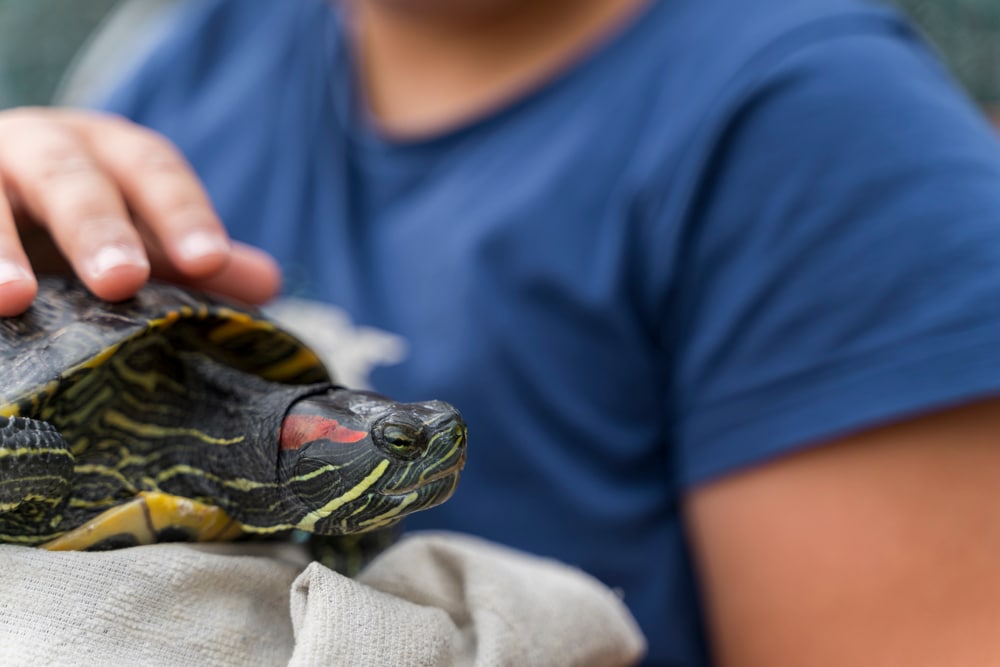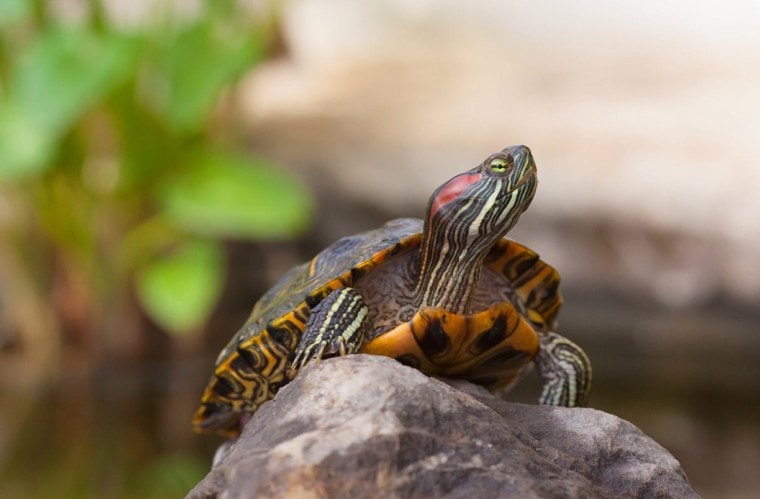
If you were thinking about getting a red-eared slider for your next reptile, you’ll find yourself adopting the most popular pet turtle in the world! Both novice and experienced owners can enjoy these turtles because of the unique experience they offer.
But as with any other pet, they have unique needs. If you want to know more about the red-eared slider, you’ve come to the right place. Here, we go over what it’s like to own one of these turtles and how you can adequately care for them.
Red-Eared Slider Turtle Facts
Before you adopt a red-eared slider, you might want to brush up on the facts. Let’s learn a bit about where this turtle came from.
History
The red-eared slider (Trachemys scripta elegans) is native to many southern states across the United States, all the way down to the Gulf of Mexico. This freshwater-aquatic turtle gained quite a bit of traction in the 1950s in the United States.
Despite being termed as an aquatic turtle, they do spend a fair bit of their time outside the water. Nonetheless, they are extremely proficient swimmers when they do decide to enter water.
Some speculate that the real fascination for pet red-eared sliders began in the 1930s, when the Ralston Purina cereal company started advertising coupons for free baby turtles. This marketing tactic boomed, sealing the fate of red-eared slider babies everywhere.
Suddenly, red-eared sliders were available through companies, at fairs or carnivals, and in pet stores. They were inexpensive and easy to come by. Soon, these baby turtles were known as dime-store turtles, becoming pets to kids everywhere.
This marketing hype was more trouble than it was worth, though, as several baby turtles wound up in bad situations. Many youngsters didn’t know much about proper turtle care, and neither did their parents. It led to many premature deaths.
Turtles are natural carriers of Salmonella bacteria strains; they can appear perfectly healthy while harboring the bacteria (this is termed as being an asymptomatic carrier). Because children could very easily fit small turtles into their mouths, the US government (via the FDA) issued a ban for the sale of baby turtles under 4 inches in shell length since 1975. This law is in effect even today. It is therefore crucial that you check local laws before adopting a new turtle species wherever you reside.
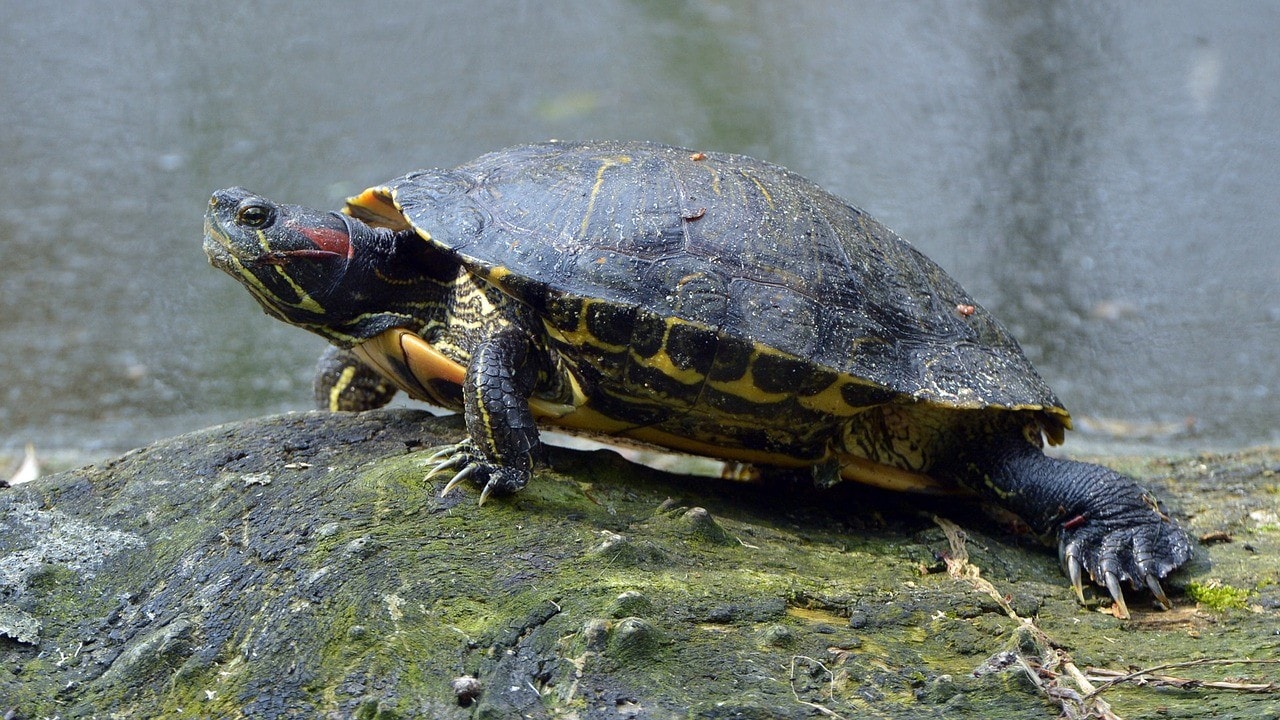
Pets Today
Today, you might not find a red-ear slider coupon in your Shredded Wheat, but you will find them elsewhere. Since light has shone on the neglect, cruelty, and brutal nature of careless turtle distribution, these critters usually wind up in good homes these days.
They are still considered one of the “best” turtles that you can have as a pet. But learning essential care is paramount.
Size
When you buy a red-eared slider, they might only fit in the crook of your hand. But don’t let their tiny size fool you—these turtles can get big. An adult red-eared slider can be 12-15 inches long (30-40 cm) and weigh about 6 pounds (just over 2 kg).
Varieties
While red-eared sliders will have their own unique designs and colors, they all share the same classic look. You can find red-eared sliders in combinations of brown, red, yellow, light blue, and green.
Lifespan
If you have a healthy red-eared slider, they can live up to 20-30 years. It isn’t beyond the realm of possibility to have a pet live longer, with there being verified records of an individual living to over 40 years 1. So, it’s essential to prepare mentally for the commitment.

Are Red-Eared Sliders Good Pets?
Red-eared sliders can make terrific pets, providing that you’ve done your research on turtle care. This species is a semi-aquatic turtle that requires a specific tank with freshwater, plants, basking spots, and appropriate space. Larger turtles are better suited for outdoor enclosures with a pond. Turtles do not make great pets for children, the elderly, or immunocompromised individuals.
Where Can I Get a Red-Eared Slider Turtle?
You can adopt a red-eared slider from many pet stores and aquatic shops. You might also find them from local breeders or hobbyists. Depending on age and variety, these turtles can range from $5 to $100 or more.
Before you bring home your red-eared slider, have a veterinarian check them for any oddities to make sure they are healthy and issue free. Most adoption programs and policies have a grace period during which you can have your pet checked over by a veterinarian for health issues of major concern.
How Much Does It Cost to Own a Red-Eared Slider?
A red-eared slider might seem like an inexpensive pet that is easy to take care of—and you’re partially correct. But every aquatic pet requires a significant commitment, which includes keeping up with tank maintenance and proper health and replenishing supplies.
Startup Costs
Startup costs will typically be the most expensive part of turtle owning. You have to get the tank, plants, and other supplies necessary for care. For total initial costs, including the turtle, plan to spend between $100 and $350.

Food Costs
Food costs will either stay the same or slightly decrease as your turtle gets bigger; this is because juveniles require more high-protein foods, which typically end up costing more than the high amounts of plant matter adults consume. If you have a singular adult turtle, you can expect to pay roughly $30 a month on chow.
Vet Bills
Before you even bring home your red-eared slider, you should find an exotic vet that is local to you. It is also worthwhile to check if any pet insurance company near you covers veterinary costs for exotic pets. As exotic veterinary practice is considered a speciality which requires several years of training, the charges for an exotic veterinarian’s services might be somewhat pricey, depending on where you reside.
Most facilities charge $80 to $100 just for the initial visit, not including any testing or medications that they might administer. Compare rates and the credibility of available exotic vets near you.
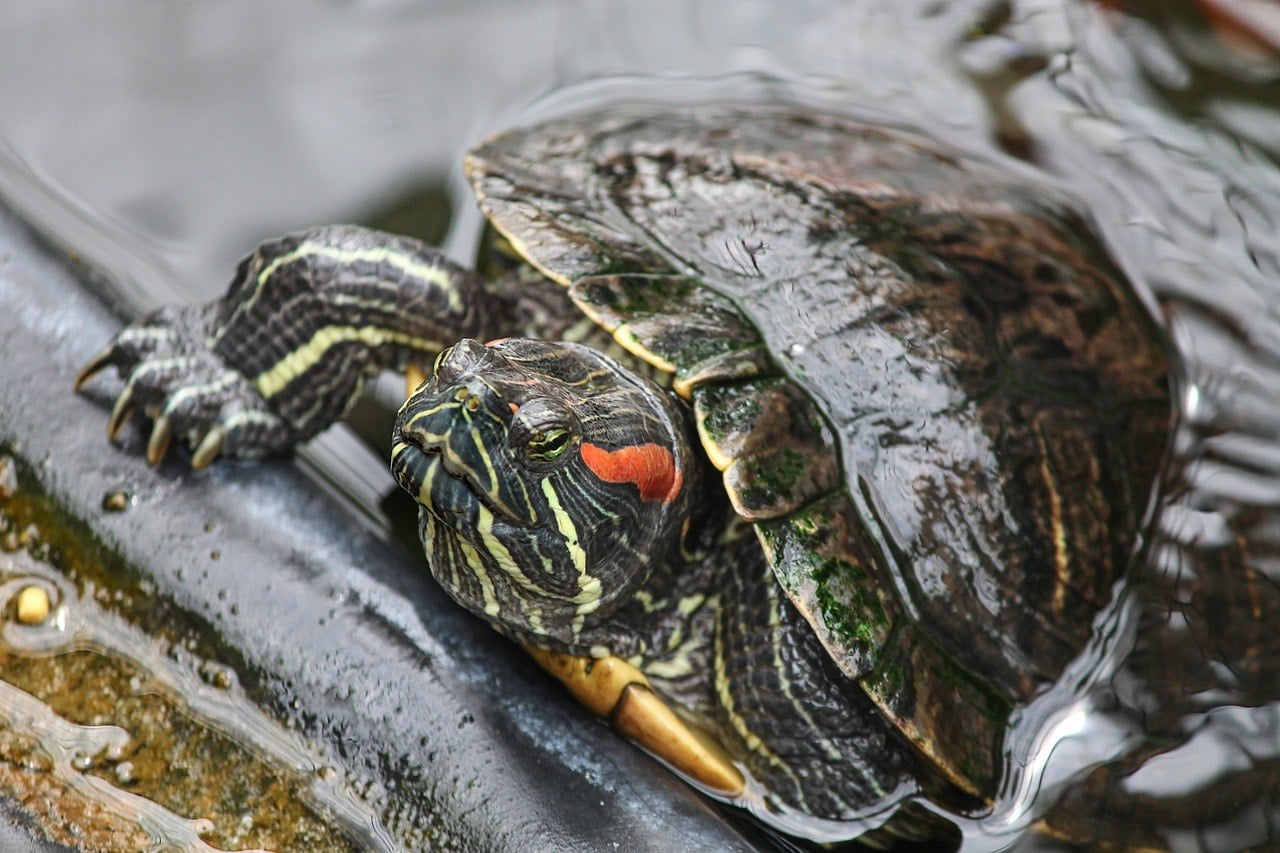
What Kind of Home Does My Red-Eared Slider Need?
Your turtle’s habitat is the most important place in the world—it’s their sanctuary. So, it would be best to get the best supplies and not skip crucial needs.
Tank Size
As hatchlings, red-eared sliders need at least a 30-gallon tank. A good rule of thumb is to increase the tank by 10 gallons for every inch of your turtle’s size. Since red-eared sliders reach up to 12 inches, you can opt for a 100- to 120-gallon tank up front or increase the size as they grow. Alternatively, you can set up an outdoor enclosure for your pet once they’re older, the exposure to natural sunlight is a welcome addition to any pet turtle’s welfare. Larger turtles are a large number of juveniles and are often housed in outdoor enclosures and ponds. Even if you have a single turtle, allowing them the opportunity to spend at least part of each year (the summer months) in a secure outdoor enclosure is advised by veterinarians 2.
While setting up an aquarium, it is important to note that around ⅓ of the area should be non-water, and should allow your pet to completely surface out of the water and relax. Red-ear sliders benefit from a swimming space that’s at least 30 cm (12 inches) deep; this contributes to their welfare.
Substrate
Since these turtles are semi-aquatic, they will need plenty of time in the water and have a spot for basking on land. However, they don’t require substrate. A bare tank bottom is sufficient for their well-being. But if you like the look of a decorated bottom, you can get gravel or pebbles, however, these shouldn’t be big enough for your pet to pick up in their mouth, as it may lead to impaction. Sharp gravel can also scrape their plastron (under side). Generally speaking, the few risks and additional cleanup difficulties associated with substrate makes it somewhat undesirable in a red-ear slider’s enclosure.
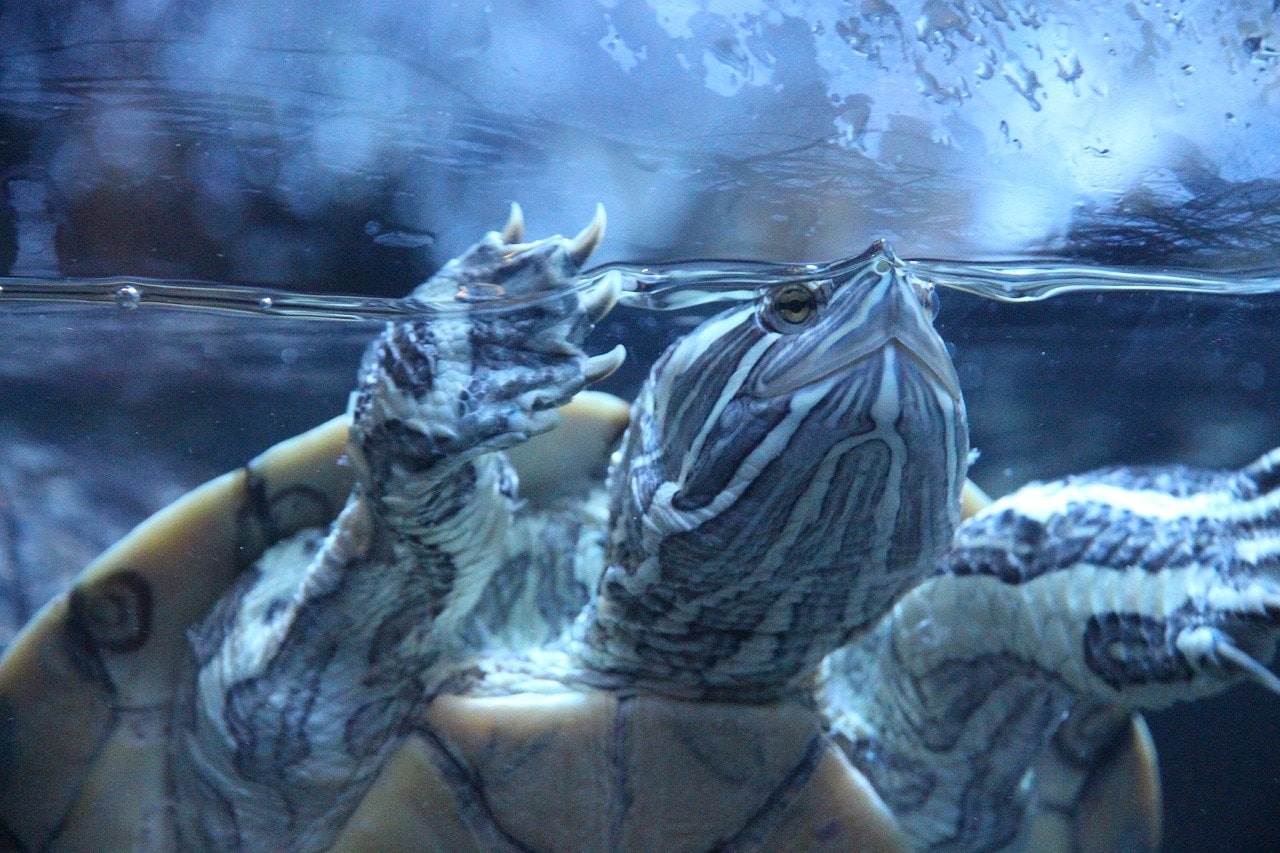
pH Levels
The pH levels for a red-eared slider tank should stay between 6.0 and 8.0.
Lighting
Red-eared sliders need ultraviolet light for calcium balance. Red ear sliders require broad spectrum lighting (UVB 290-300 nm). Their UV lamp should be checked to see if it also provides heat, if it doesn’t offer this function, you’ll need to also get them a heat lamp (for their basking spot). All bulbs and light fixtures should be regularly maintained and replaced to ensure that they’re working properly.
The light source should be 12 inches or higher from your turtle during daylight hours, which should be roughly 12 hours per day. During nighttime hours, you should shut off the lamp for a proper sleep/wake cycle.
Heat
Red-eared sliders need a basking area to warm themselves, and like all pets, have certain temperature requirements.
Their tank should be maintained between 22–27 °C (72 – 81 °F). The temperature of their basking spot should be approximately 32 °C (around 90 °F), whereas nighttime temperatures should not fall below 17 °C (63 °F).
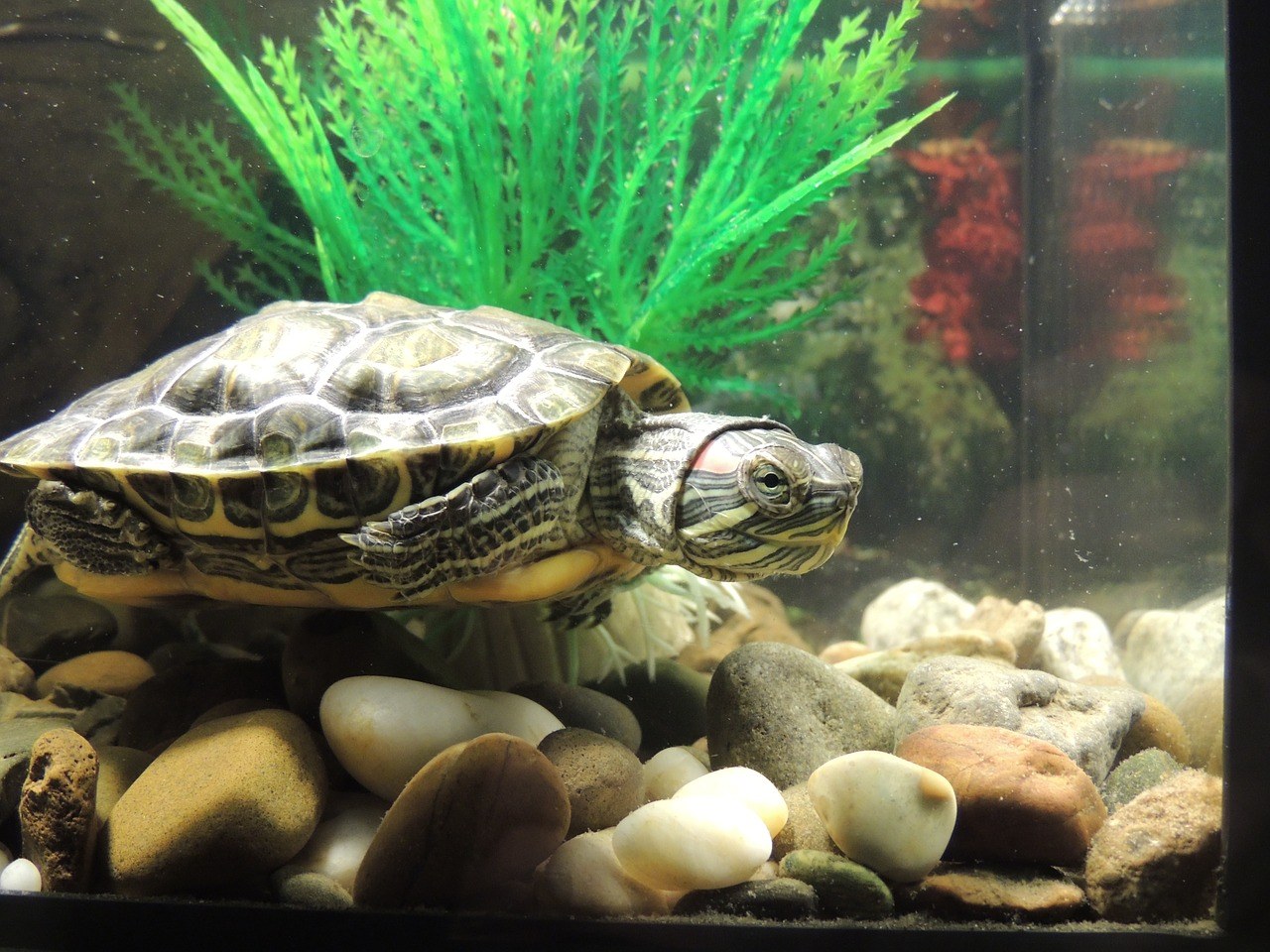
Décor
You can decorate the cage as you see fit with either artificial or live plants. You can also place aquarium-friendly objects to make the setup aesthetically pleasing. Take note that these turtles are foragers and will eat most aquatic plants; you would want to be careful and not place a prized plant in their tank.
Tank Mates
You can have more than one red-eared slider, but you should have the tank or pond space to accommodate both.
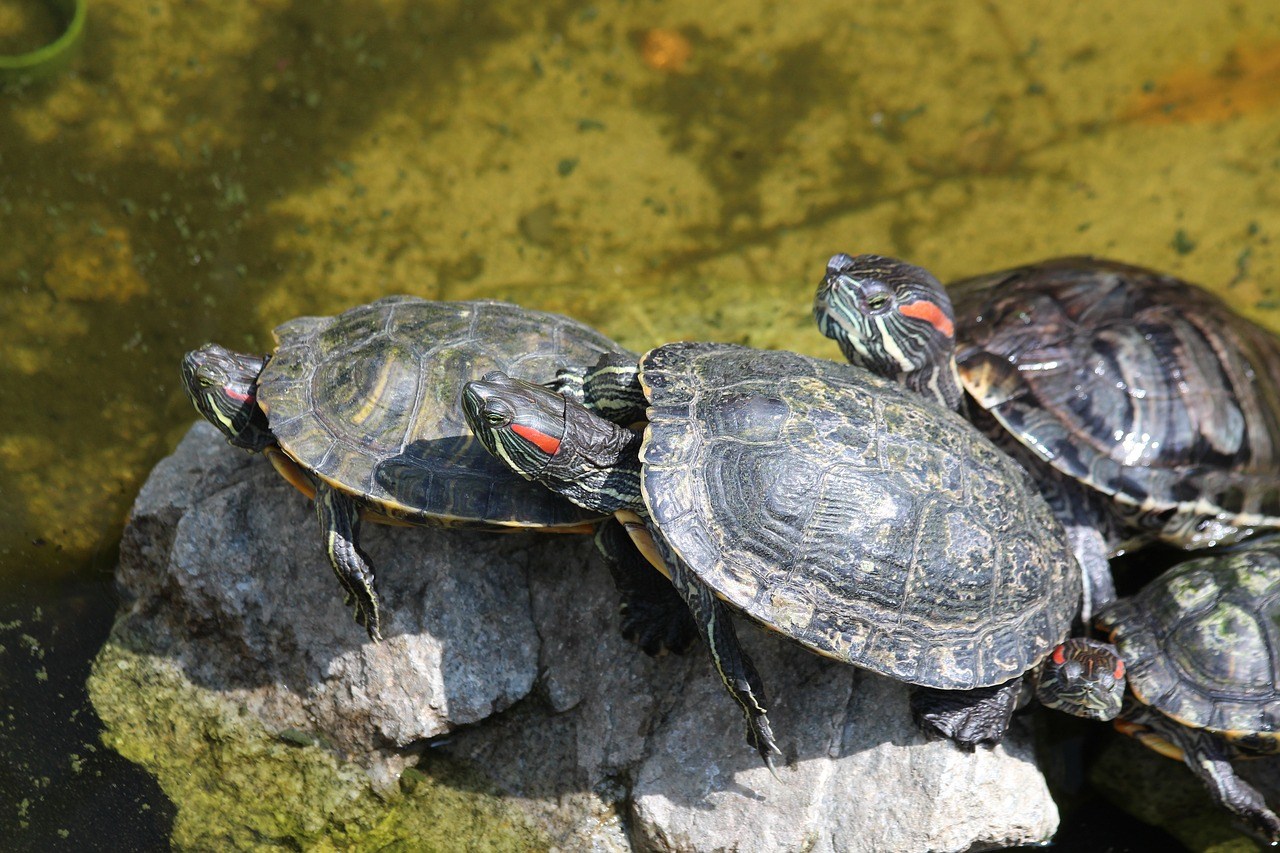
What Should I Feed My Red-Eared Slider?
Red-eared sliders are omnivorous, meaning they eat both plant and animal matter. In the wild, they feast on aquatic plants and small animals, like tadpoles, insects, and any fish they can catch. As pets, they can also eat commercial turtle food. You can find red-eared slider pellets at local pet shops or online for purchase.
Other foods safe for them include
Please note that this list isn’t exhaustive, and your turtle’s nutritional needs will depend on a variety of factors. Red ear sliders are opportunistic foragers and may always appear hungry.
Generally speaking, juveniles will require a more animal-meat heavy diet, whereas adults require more plant-based foods in their diet. It is very important to discuss your pet’s nutritional needs with your veterinarian; keep in mind that overfeeding a turtle (especially when they are young) is very detrimental to their long term health.
How Do I Take Care of My Red-Eared Slider?
Knowing how to care for your turtle appropriately is essential to lifelong happiness. Here are key care tips for your red-eared slider.
Meals
You should feed your red-eared slider with a meal plan that you establish with the assistance of your veterinarian or a reptile nutritionist. Generally speaking, a juvenile turtle will need to eat more frequently (often on a daily basis) than an adult would. Exceptionally young turtles might need multiple meals a day, and therefore, time commitment is a factor to consider when you raise these pets.

Handling
You might be able to hold your red-eared slider sometimes, but it does cause them stress. So, try to keep sessions short or pet them in their enclosure instead. Due to the inherent risk of Salmonella that all turtles possess, they should only be handled when absolutely necessary. You should also thoroughly wash and dry your hands both before and after handling them.
Filters
You can use submersible or internal filters for your turtle’s water. These turtles are exceptionally messy, and require exceptionally powerful filters in their aquarium. You may have to modify the filter’s intake to ensure it can catch their poop, filters intended for fish often have an intake too small to catch turtle poop. Instead, it often gets stuck on the intake, limiting the filter’s water intake rate.
Habitat
Old food and waste can get the tank dirty quickly, so always make sure to clean gravel or remove remnants of food as needed. The frequency will depend on how big the mess is and how many turtles you have.
Because turtles may carry Salmonella, the current consensus in veterinary literature is to do a full water change on a weekly basis, as this minimizes the risk of cross contamination. This is also why it isn’t recommended to house turtles with fish; not only will they consider the fish as prey, but fish cannot withstand complete water changes.
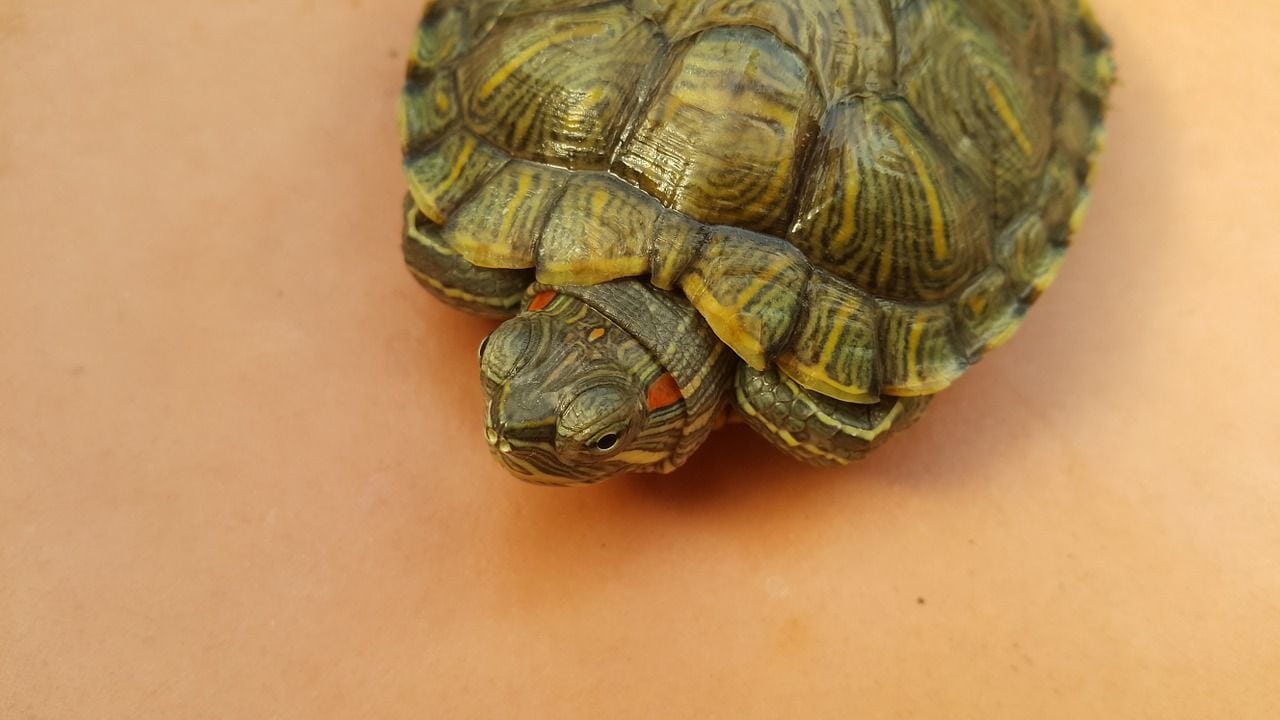
How Do I Know If My Red-Eared Slider Turtle Is Sick?
When properly cared for, these turtles are typically healthy critters. But they can still run into issues. Here are a few common ailments and their signs.
Cystic Calculi
This disease causes minerals to crystallize in the urine, which leads to bladder stones. Blood in your turtle’s droppings is a sign that something isn’t right. Routine veterinary care and dietary assessment from a professional can help circumvent this issue or catch it earlier on.
Skin and Shell Sloughing
A healthy scute that sheds off your turtle’s shell appears transparent and is replaced with a new scute underneath, without revealing any skin. The rate at which a healthy turtle sheds their scutes depends on their age and growth rate. Most adults only shed their scutes once a year, juveniles may shed their scutes more frequently.
If your turtle is shedding scutes excessively, or if their skin looks like it is “peeling”, they require prompt veterinary care.
Shell Trauma
Your turtle’s shell is hard and protective, but even it can’t hold up with great force. The most common reason why turtles end up with a broken shell as pets is because of an unfortunate interaction with other pets (such as cats or dogs). Turtles that are too young may be vulnerable to predators if housed outdoors and attacked by a predator.
Shell Growth Issues
There are two aspects of shell growth to consider for pet turtles. The first is a malformed shell that is too weak, either due to an imbalanced diet or insufficient exposure to UVB or sunlight. This is also sometimes collectively referred to as metabolic bone disease.
The other shell growth issue is caused by overfeeding or excessive nutrition. This results in your pet’s shell appearing pointed and pyramid shaped. This is termed as shell pyramiding. Contrary to popular belief, this doesn’t mean your pet’s shell is “tougher” or “stronger”. On the contrary, a malformed shell puts excessive pressure on the rest of your pet’s body, and may lead to muscle issues, joint issues, and in some cases may even affect their internal organs considerably. Females are especially susceptible to egg laying issues if they’d had shell pyramiding as juveniles.
Dystocia/Egg Binding
Dystocia refers to the difficulty a female pet turtle may experience when it comes to laying eggs. Dystocia can be caused by several factors, and always requires veterinary care (it should be considered an emergency). Take note that females can lay eggs in the absence of a male, the lack of a male doesn’t mean your pet may not be at risk for dystocia. As turtles don’t give birth to live young, this is also sometimes referred to as egg binding.
If you have a female pet, pay very close attention to her as she swims. Often, the first signs of dystocia are very subtle and appear as a female that cannot easily surface due to the weight of her eggs pushing her down as she swims. Such signs usually appear before other, more obvious signs of dystocia (such as lethargy, a lack of appetite, the inability to pass eggs, paralysis of the hind legs) appear.
Final Thoughts
Red-eared sliders can be incredibly rewarding reptiles to own. Like all pets though, they do have unique characteristics and requirements which must be factored in prior to them being adopted.
If all this information has made you positive that you want a red-eared slider, good luck with your turtle search! You can find these cute critters easily, but don’t discount the input of a veterinarian to ensure that they get the best care possible.
- Related Read: Where to Buy a Red-Eared Slider Turtle
Featured Image Credit: Sergii Votit, Shutterstock



